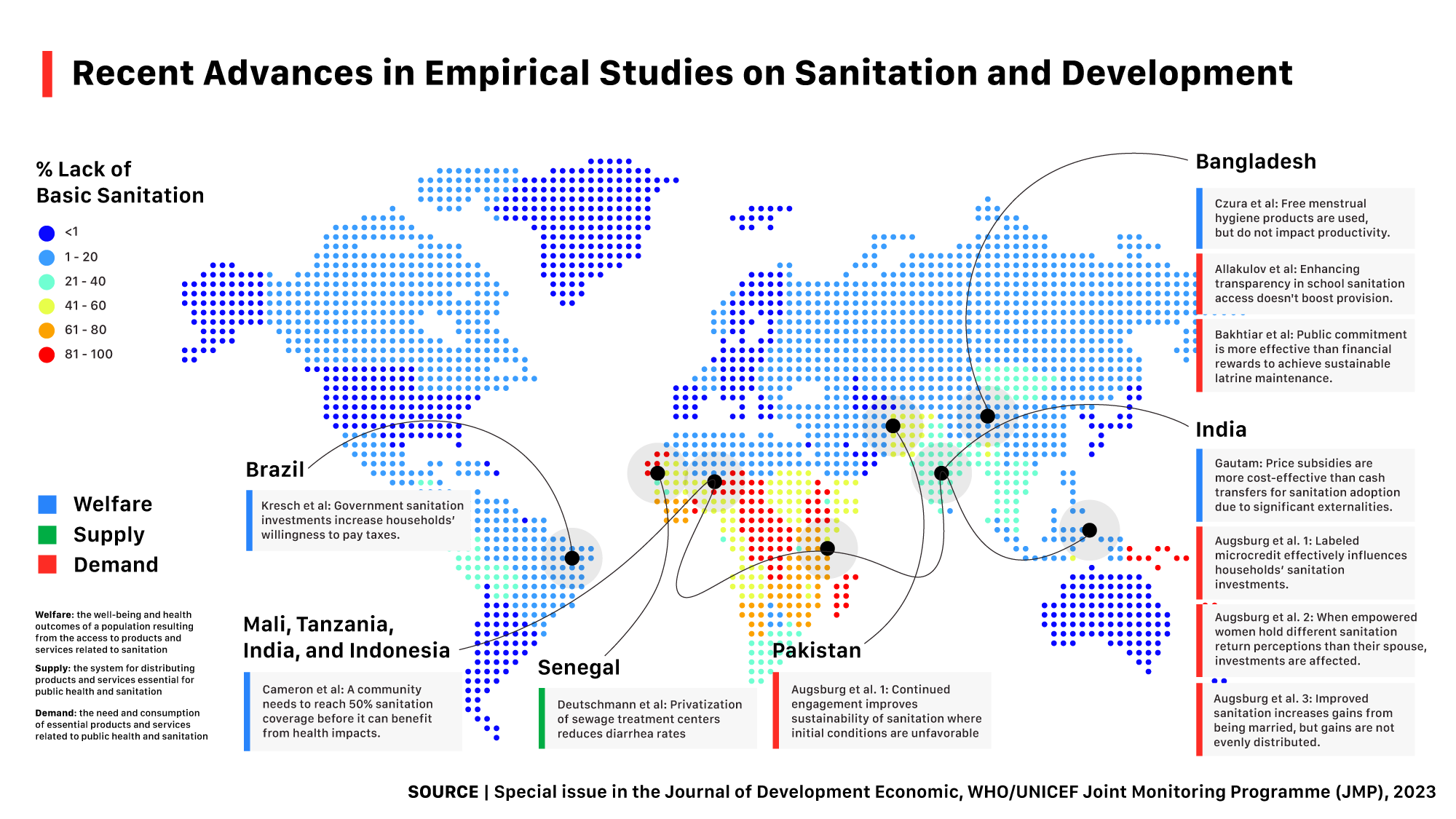
To effectively improve sanitation in low-income areas, policy must address a number of key issues, including credit market failures, environmental externalities, social preferences and low public sector capacity
Sanitation investments are needed but lacking
The unsafe disposal of human faeces is a global problem – more than 80% of the world’s sewage is discharged into the environment without treatment (UN Water 2017), and 1.7 billion people, mostly in low- and middle-income countries, lack access to safe sanitation infrastructure or use unsafe facilities (WHO/UNICEF 2020). The epidemiology literature has contributed significantly to our understanding of the link between unsafe water, sanitation and hygiene (WASH) and health. This evidence convincingly supports the case for investment (WHO 2012).
Costs are an often-cited hurdle
Yet sanitation provision can be costly. The World Bank estimates that meeting WASH targets globally requires US$19.5 billion annually (Hutton & Varughese 2016). Therefore, it is crucial to improve financing mechanisms for such investments. As the Asian Development Bank Institute, an active supporter of WASH as an effective development strategy, recently highlighted: "Policymakers and practitioners must prioritize institutional design and effective intermediation and transaction cost mechanisms to address financing challenges. […] innovative financing models and mechanisms are necessary to improve public health and the environment in the sanitation sector". (Wibowo et al. 2023).
They are however only part of the full picture
The Journal of Development Economics, with financial support from the ADBI and BMGF, has supported the publication of economists’ contributions that (i) broaden our understanding of the causal welfare effects of sanitation interventions, both in terms of public health as well as less ‘traditional’ outcomes, such as a government’s tax collections, (ii) provide insight into the effective delivery of services and infrastructure, particularly in view of financing, pricing, and supply side changes, and (iii) start to tackle questions about behavioural issues around infrastructure maintenance and sustainability.
Figure 1: Recent advances in empirical studies on sanitation and development

What we learn…
…about health impacts
It is well established that improved sanitation can lead to significant health improvements (Fewtrell et al 2005, Cumming and Cairncross 2016, Alsan and Goldin 2019, Galiani et al. 2005, Watson 2006, Kesztenbaum and Rosenthal 2017, Geruso and Spears 2018, Bhalotra et al. 2021, Augsburg and Rodriguez-Lesmes 2018, Pickering et al. 2015, Spears 2020, Pickering et al. 2015). However, achieving these health gains is all but straightforward. A review of the literature by Kresch et al. (2019) for example shows that common interventions targeted at households being the drivers of WASH improvements are often far less effective in improving health outcomes than previously hoped by many sanitation policymakers. Large impacts on, for example, child mortality tend to have been found only with large-scale and/or structural water and sanitation infrastructure investments and knowledge gaps remain as to when and how health impacts can be achieved. Two special issue contributions, Cameron et al. (2023) and Deutschman et al. (2023), shed light on mechanisms behind health impacts. Cameron et al. (2023) establish that the commonly implemented behavioural change intervention, Community-Led Total Sanitation (CLTS), is unlikely to have any health impact until community coverage of 50% is achieved: pooling data from four countries, they find increases in child health of 0.3 standard deviations once village sanitation coverage reaches 50–75%. There do not appear to be statistically significant gains beyond the 75% threshold. Deutschman et al. (2023) on the other hand show that privatisation of sewage treatment centres led to a reduction in diarrhoea rates among children in Dakar relative to other cities in Senegal, with the main effects following from increased productivity from the desludging operators based on their ability to complete more jobs during the days following privatisation.
…about impacts on non-traditional outcomes
Earlier work by economists has established that unsafe sanitation can increase psycho-social stress (Sahoo et al. 2015), hamper human capital outcomes other than health (Spears and Lamba 2015) and constrain economic growth (WSP 2011). Three contributions in the special issue widen this known set of non-health sanitation benefits: Kresch et al. (2023) demonstrate that sanitation services are part of the social contract, where citizens pay taxes in exchange for government-provided services. Therefore, the government may not bear the full cost of expanding coverage as tax revenue may increase with improved services. Augsburg et al. (2023a) find that the impact of effective sanitation interventions can make a family more attractive for marriage, though the improvement in sanitation may be mirrored by a decrease in a wife’s surplus share in other realms. At the same time, we learn from Czura et al. (2023) who study improved WASH in the context of Bangladeshi garment workers that access to menstrual hygiene products does not necessarily lead to increased work productivity.
…about optimal policy design
Improving sanitation cost-effectively is crucial for the long-term success of the sector and governments’ ability to maximise the value of their investments. Despite its potential, failure to achieve necessary change may hinder impact. Four contributions in the special issue further our understanding on three key channels for optimal investment in sanitation: increasing willingness to pay to improve demand, making improvements to the supply side, or government information provision and behaviour modeling.
Governments can improve sanitation by increasing a household’s ability and willingness to pay, particularly considering that, in many contexts, adding a toilet can cost as much as 50% of average household annual income. Deb et al. (2024) evaluate the Government of India’s flagship sanitation policy, the Clean India Campaign, as implemented in the northern state of Punjab, combining a behavioural change campaign with financial incentives. They find that while on average the intervention induces marginal households to invest and reduce open defecation, it far from eliminates this practice - a fact consistent with basically any intervention aimed at tackling open defecation. Augsburg et al. (2023b) show that a standard microfinance product (that provides cash, rather than materials to clients as evaluated in BenYishay et al. 2017) serves as an accelerator for households wanting to purchase latrines—especially households which may have access to subsidies which are paid only after the latrine is installed, leaving them severely cash-constrained in the interim: they find that latrine provision increases by 19 percentage points among those that receive access to labelled loans. Yet solving the liquidity problem may not be sufficient to increase household willingness to invest. Using the same data, Augsburg et al. (2023c) demonstrate that cost and benefit perceptions of sanitation investments, and particularly the differences of perceptions within a household, are important drivers of a household’s decision to borrow for sanitation, and to actually use the loan to construct a toilet.
Subsidies may ultimately be necessary to increase sanitation uptake, particularly among the poorest. Gautam (2023) demonstrates an untargeted price subsidy can be more cost-effective than targeted cash transfers in terms of increasing sanitation adoption overall, due to the significant externalities associated with sanitation provision. Untargeted subsidies can be costly, particularly as many households would participate without them. This work complements a recent study by Johnson and Lipscomb (2023), which shows that price discrimination in subsidised sanitation provision by the government or other authority can substantially increase take up and health improvements while minimising the budget required.
However, providing services at the household level, even when highly subsidised, may remain inadequate. To achieve welfare impacts and improve financing, the government’s most cost-effective investments may occur through changes at the government or supply side level rather than changes at the household level. Governments often operate the sanitation supply chain, but they may do so inefficiently. Deutschman et al. (2023) show that privatising sewage treatment centers increased legal sewage dumping by 74%. Additionally, households pay 5% less for sanitation services after privatisation, and diarrhoea rates among children decreased.
We also learn that improving sanitation quality at schools and government buildings can increase household awareness of improved sanitation. However, working toilets at schools are often unavailable, and providing information alone may not be sufficient: Allakulov et al. (2023) demonstrate that deliberative stakeholder workshops, which aim to improve transparency, do not enhance service provision or alter usage patterns. This suggests that there is unlikely to be a “trickle down” effect to household-level improvements.
…about sustainability
Although building and implementing sanitation infrastructure is crucial, the long-term impact of sanitation interventions has been inconsistent. Studies have shown that maintenance of sanitation investments is often inadequate, resulting in a return to open defecation (Tyndale-Biscoe et al. 2013, UNICEF, 2014). Two special issue contributions suggest avenues to counteract such reversal to unsafe sanitation: Augsburg et al. (2022) demonstrate that follow-up activities can counteract abandoning of toilet investments where initial conditions are unfavourable. However, this requires sustained dedication at the government level to maintain a budget and follow up on the project, rather than simply committing to a one-off project.
Bakhtiar et al. (2023) reveal that creating and maintaining social norms is crucial. They demonstrate that financial rewards have the strongest impact in the short term (three months), inducing a 7.5–12.5 percentage point increase in hygienic latrine ownership, but this effect dissipates in the medium term (15 months). In contrast, a public commitment at the household level induced a 4.2–6.3 percentage point increase in hygienic latrine ownership in the short term, and this effect persists in the medium term. Non-financial social recognition or a private pledge has no detectable effect on sanitation investments.
Takeaway
A common theme throughout this special issue is that to be successful, improvements in sanitation in low-income areas must address a number of key issues, including credit market failures, environmental externalities, social preferences and low public sector capacity. For example, it is not enough just to provide technology, but also to ensure its maintenance and use. The studies presented provide insights into how different programmes have attempted to address these multiple constraints through interaction with households, communities and businesses. From this perspective, it is hoped that these papers can help provide a roadmap for social planners interested in advancing this important agenda.
References
Augsburg, B and P A Rodriguez-Lesmes (2018), "Sanitation and child health in India", World Development, 107: 22–39, https://doi.org/10.1016/j.worlddev.2018.02.005
Curtis, V, L O Danquah, R V Aungar, and V A C (2009), "Planned, motivated and habitual hygiene behaviour; an eleven country review", Health Education Resources, 24: 655-73.
Deb, S, G Joseph, L Andrés, and J G Zabludovsky, "Is the Glass Half Full or Half Empty? Examining the Impact of Swatch Bharat Interventions on Sanitation and Hygiene in Rural Punjab, India", Journal of Development Economics, conditional accept.
Deutschmann, J, J Gars, J F Houde, M Lipscomb, and L Schechter, "Privatization of Public Goods: Evidence from the sanitation sector in Senegal", Journal of Development Economics, v160.
Dickinson, K L, S R Patil, S K Pattanayak, C Poulos, and J H Yang (2015), "Nature’s call: Impacts of sanitation choices in Orissa, India", Economic Development and Cultural Change, 64(1): 1–29, https://doi.org/10.1086/682958
Graff Zivin, J and M Neidell (2013), "Environment, Health, and Human Capital", Journal of Economic Literature, 51(3): 689-730.
Hutton, G and M Varughese (2016), "The Costs of Meeting the 2030 Sustainable Development Goal Targets on Drinking Water, Sanitation, and Hygiene", World Bank, Washington, DC, http://hdl.handle.net/10986/23681, License: CC BY 3.0 IGO.
Johnson, T and M Lipscomb (2023), "Pricing People into the Market: Targeting through Price Discrimination", Working Paper.
Kresch, E P, M Walker, M C Best, F Gerard, and J Naritomi (2023), "Sanitation and property tax compliance: Analyzing the social contract in Brazil", Journal of Development Economics, 160: 102954.
Kumar, S and S Vollmer (2013), "Does access to improved sanitation reduce childhood diarrhoea in rural India?", Health Economics, 22(4): 410–27, https://doi.org/10.1002/hec.2809
Pickering, A, H Djebbari, C Lopez, M Coulibaly, and M L Alzua (2015), "Effect of a community-led sanitation intervention on child diarrhoea and child growth in rural Mali: A cluster-randomised controlled trial", Lancet Global Health, 3(11): 701–11, https://doi.org/10.1016/S2214-109X(15)00144-8
Ross, I (2022), "Using water-adjusted person years to quantify the value of being water secure for an individual's quality of life", Water Research, 227: 119327, https://doi.org/10.1016/j.watres.2022.119327
Ross, I, O Cumming, R Dreibelbis, A Zaida, R Nala, and G Greco (2021), "How does sanitation influence people's quality of life? Qualitative research in low-income areas of Maputo, Mozambique", Social Science & Medicine, 272: 113709, https://doi.org/10.1016/j.socscimed.2021.113709
Spears, D (2020), "Exposure to open defecation can account for the Indian enigma of child height", Journal of Development Economics, 146: 102277, https://doi.org/10.1016/j.jdeveco.2018.08.003
Sahoo, K C, K R S Hulland, B A Caruso, R Swain, M C Freeman, P Panigrahi, and R Dreibelbis (2015), "Sanitation-related psychosocial stress: A grounded theory study of Women across the life-course in Odisha, India", Social Science & Medicine, 139: 80–89
Spears, D and S Lamba (2015), "Effects of early-life exposure to sanitation on childhood cognitive skills: Evidence from India’s Total Sanitation Campaign", Journal of Human Resources, 51: 298–327, https://www.jstor.org/stable/24736024
Tyndale-Biscoe, P, M Bond, and R Kidd (2013), "ODF sustainability study".
UNICEF (2014), "Evaluation of the WASH sector strategy ‘Community approaches to total sanitation (CATS)’, executive summary", UNICEF Evaluation Office.
UN Water (2017), "2017 UN World Water Development Report, Wastewater: The Untapped Resource".
Water and Sanitation Program (2011), "The economic impacts of inadequate sanitation in India", https://documents.worldbank.org/en/publication/documents-reports/documentdetail/820131468041640929/economic-impacts-of-inadequate-sanitation-in-india
WHO (2012), "Global costs and benefits of drinking-water supply and sanitation interventions to reach the MDG target and universal coverage", WHO/HSE/WSH/12.01
Wibowo, D, M Bennon, and KE Seetha Ram (2023), "Long-Term Financing for City-Wide Inclusive Sanitation", ADBInstitute Policy Brief No.2023-3 (April).






